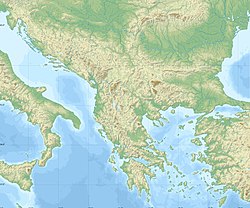
Back روسه Arabic Ruse AST Ruse Azerbaijani روس, بولغاریستان AZB Русэ Byelorussian Русэ BE-X-OLD Русе Bulgarian Rouse Breton Russe Catalan Русе CE
Ruse
Русе | |
|---|---|
City | |
 Top: Ruse Courthouse Middle left: Ruse Street Ballons Festival Middle right: Dohodno Zdanie (Sava Ornianov Theater) Bottom left: Monument of Freedom Bottom middle: Lyuben Karavelov Library Bottom right: Ruse International Sand Sculpture Festival | |
| Nickname(s): | |
| Coordinates: 43°49′23″N 25°57′14″E / 43.82306°N 25.95389°E | |
| Country | Bulgaria |
| Oblast | Ruse |
| Government | |
| • Mayor | Pencho Milkov (BSP) |
| Elevation | 45 m (148 ft) |
| Population (2022)[1] | |
| • City | 123,134 |
| • Urban | 139,226 |
| Time zone | UTC+2 (EET) |
| • Summer (DST) | UTC+3 (EEST) |
| Postal Code | 7000 |
| Area code | +359 82 |
| Website | www |
Ruse (also transliterated as Rousse, Russe; Bulgarian: Русе [ˈrusɛ]) is the fifth largest city in Bulgaria. Ruse is in the northeastern part of the country, on the right bank of the Danube, opposite the Romanian city of Giurgiu, approximately 67 km (42 mi) south of Bucharest, Romania's capital, 172 km (107 mi) from Varna, and 249 km (155 mi) from the capital Sofia. Thanks to its location and its railway and road bridge over the Danube (Danube Bridge), it is the most significant Bulgarian river port, serving an important part of the international trade of the country. It is the 12th largest of all cities on the Danube river.
Ruse is known for its 19th- and 20th-century Neo-Baroque and Neo-Rococo architecture, which attracts many tourists. It is often called the Little Vienna.[2][3] The Ruse-Giurgiu Friendship Bridge, until 14 June 2013 the only one in the shared Bulgarian-Romanian section of the Danube, crosses the river here.
Ruse is the birthplace of the Nobel laureate in Literature Elias Canetti and the writer Michael Arlen.
Ruse is on the right bank of the river Danube, which is the high bank, having two underwater terraces and three river terraces at 15 to 22 m (49.21–72.18 ft), 30 to 66 m (98.43–216.54 ft), and 54 to 65 m (177.17–213.25 ft). The average altitude is 45.5 m (149.28 ft) AMSL. The urban area is an approximately 11-km ellipse running along the river. The city extends from the land-connected Matey (Матей) island and the mouth of Rusenski Lom on the west to Srabcheto (Сръбчето) hill on the east. During the 20th century, the west end of the city was significantly modified by moving the mouth of Rusenski Lom to the west, as well as by moving the bank itself with its fairway considerably to the north. Sarabair (саръбаир, from Turkish Sarıbayır meaning "Yellow Slope") hill is to the south of the city and is 159 m (521.65 ft) high. The Rousse TV Tower is built there on the remains of Leventtabia, a former Turkish fortification.
- ^ НАСЕЛЕНИЕ КЪМ 31.12.2022 Г. ПО ОБЛАСТИ, ОБЩИНИ, МЕСТОЖИВЕЕНЕ И ПОЛ nsi.bg
- ^ Martinov, Krassimir; Daniela Konstantinova (12 January 2007). "Neighborly: Balkan developments". Radio Bulgaria. Archived from the original on 25 March 2007. Retrieved 27 December 2008.
... Ruse's image as The Little Vienna: a name given to the Bulgarian city for its wonderful architecture.
- ^ "Little Vienna Under the Bridge". Sofia News Agency. 16 February 2007. Retrieved 27 December 2008.
Rousse's architecture inspires locals to call it the 'Little Vienna'.
© MMXXIII Rich X Search. We shall prevail. All rights reserved. Rich X Search



